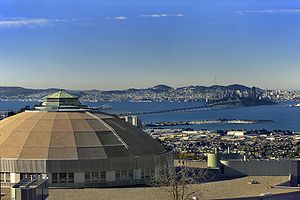
Advanced Light Source
Encyclopedia


Lawrence Berkeley National Laboratory
The Lawrence Berkeley National Laboratory , is a U.S. Department of Energy national laboratory conducting unclassified scientific research. It is located on the grounds of the University of California, Berkeley, in the Berkeley Hills above the central campus...
in Berkeley
Berkeley, California
Berkeley is a city on the east shore of the San Francisco Bay in Northern California, United States. Its neighbors to the south are the cities of Oakland and Emeryville. To the north is the city of Albany and the unincorporated community of Kensington...
, California
California
California is a state located on the West Coast of the United States. It is by far the most populous U.S. state, and the third-largest by land area...
is a synchrotron
Synchrotron
A synchrotron is a particular type of cyclic particle accelerator in which the magnetic field and the electric field are carefully synchronised with the travelling particle beam. The proton synchrotron was originally conceived by Sir Marcus Oliphant...
light source. Built from 1987 to 1993, it currently employs 210 scientists and staff. Part of the building in which it is housed was completed in 1942 for a 4.67 m (184 in) cyclotron
Cyclotron
In technology, a cyclotron is a type of particle accelerator. In physics, the cyclotron frequency or gyrofrequency is the frequency of a charged particle moving perpendicularly to the direction of a uniform magnetic field, i.e. a magnetic field of constant magnitude and direction...
, designed by Arthur Brown, Jr. (designer of the Coit Tower
Coit Tower
Coit Tower is a tower in the Telegraph Hill neighborhood of San Francisco, California. The tower, in the city's Pioneer Park, was built in 1933 at the request of Lillie Hitchcock Coit to beautify the city of San Francisco; Coit bequeathed one-third of her estate to the city "to be expended in an...
in San Francisco) and built by Ernest O. Lawrence. Today, the expanded building houses the ALS, a U.S. Department of Energy national user facility that attracts scientists from around the world.
The ALS is a national user facility that generates intense light for scientific and technological research. As one of the world's brightest sources of ultraviolet and soft x-ray beams--and the world's first third-generation synchrotron light source in its energy range--the ALS makes what were thought to be impossible studies possible. The facility welcomes over 2000 researchers every year from universities, industries, and government laboratories around the world. It is funded by the U.S. Department of Energy's Office of Basic Energy Sciences.
The ALS has over forty beamline
Beamline
In particle physics, a beamline is the line in a linear accelerator along which a beam of particles travels. It may also refer to the line of travel within a bending section such as a storage ring or cyclotron, or an external beam extracted from a cyclic accelerator.In materials science, physics,...
s which simultaneously perform a wide range of science. Any qualified scientist can propose to use the ALS beamlines. Proposals are peer-reviewed and top-ranked proposals are allocated beam time. The ALS does not charge for beam time if the user's research is nonproprietary (results are published in open literature).
The Advanced Light Source's current director is Roger Falcone.
History
When the Advanced Light Source was first proposed in the early 1980s by former Lawrence Berkeley Lab director David Shirley, skeptics dubbed it "Shirley's Temple" and doubted the use of a synchrotron optimized for soft x-rays and ultraviolet light. According to former ALS director Daniel Chemla, "The scientific case for a third-generation soft x-ray facility such as the ALS had always been fundamentally sound. However, getting the larger scientific community to believe it was an uphill battle"In the 1987 Reagan administration budget, President Ronald Reagan allocated $1.5 million dollars for the construction of the Advanced Light Source.

